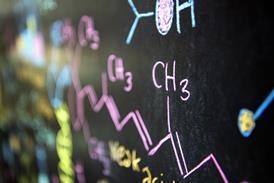All Feature articles – Page 24
-
 Feature
FeaturePhosphorus - food for thought
Can phosphorus-rich foods, such as fish, improve our intellect?
-
 Feature
FeatureInvestigating Crystal Structures
Sixthformers are introduced to Madelung constants as a way of investigating ionic crystal structures
-

-
 Feature
FeatureOcean Acidification
Recent evidence suggests that ocean removal of carbon dioxide from the atmosphere is having serious consequences for marine life
-
 Feature
FeatureSolving an infectious problem
Joseph Lister's use of phenol as an antiseptic revolutionised surgical practice in the 19th century. But was he the first to use this antiseptic technique?
-
 Feature
FeatureWhy does cotton feel 'cool'?
An investigation into the structure and properties of cellulose that make cotton clothes feel 'cool' provides a real context for undergraduate spectroscopy lab work
-
 Feature
FeatureIn pursuit of Bombykol
In 1959 Aldoph Butenandt identified and synthesised the first pheromone, bombykol. Since then scientists have discovered how male silkworm moths receive this chemical message
-
 Feature
FeatureSonochemistry - beyond synthesis
Sonochemistry, the use of sound energy to induce physical or chemical changes within a medium, has a growing number of applications in fields such as medicine and nanotechnology
-
 Feature
FeatureFluorescence lifetime imaging microscopy
Scientists are using this non-invasive technique to cast light on the workings of living cells to learn more about the molecular mechanisms involved in cancer, allergies and immune responses
-
 Feature
FeatureSurvival of the fittest
Examples of natural products produced by organisms and plants to overcome competing species and predators provide chemical evidence for Darwin's legacy of natural selection
-
 Feature
FeatureWhat is entropy?
What's the best way to introduce to your students this most misunderstood of thermodynamic properties?
-
 Feature
FeatureCatalysts for a green industry
Chemists are working to develop new, longer-lasting catalysts to ensure industrial processes are cleaner, greener and more efficient
-
 Feature
FeatureBiofuels: the next generation
Chemists look to develop second-generation biofuels made from dead wood, algae and genetically-engineered microorganisms
-
 Feature
FeatureEpilepsy - beyond bromide
An historical journey into the treatment of epilepsy, starting with potassium bromide 150 years ago
-
 Feature
FeatureBurning ice in the Arctic
Is methane trapped in ice, deep in the Arctic ocean, a potential clean energy source for the future, or will its release lead to catastrophic climate change?
-
 Feature
FeatureThe public analyst
Analytical chemists ensure everything, from food and drinks, through toys and household chemicals, to air quality and even suspicious powders present no danger to humans
-
 Feature
FeatureIda Noddack and the missing elements
Distinguished women chemists were rare in the early 20th century, but their contributions to chemistry are of great significance. Ida Noddack's scientific career centred around her intensive study of the Periodic Table, and resulted in her discovery, with husband Walter Noddack and physicist Otto Berg, of the metal rhenium, and of nuclear fission in the search for element 93.
-
 Feature
FeatureIf it smells - it's chemistry
Smell is the most chemical of all the senses - but what's the theory behind the practice?
-
 Feature
FeatureIntuitive thinking and learning chemistry
Understanding students' intuitions about the world could provide insight into their misconceptions of chemical concepts
-
 Feature
FeatureCrop protection chemicals
By 2030, the world's population is expected to rise to over eight billion - the need for safe and environmentally friendly crop protection chemical has never been greater











